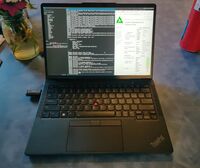Lenovo ThinkPad X13s (lenovo-21bx)
 Lenovo X13s running Sway | |
| Manufacturer | Lenovo |
|---|---|
| Name | ThinkPad X13s |
| Codename | lenovo-21bx |
| Released | 2022 |
| Type | laptop |
| Hardware | |
| Chipset | Qualcomm Snapdragon 8cx Gen 3 (SC8280XP) |
| CPU |
4x 3.0GHz (Cortex-X1) 4x 2.4GHz (Cortex-A78) |
| GPU | Adreno 690 |
| Display | 1920x1200 IPS |
| Storage | 256GB, 512GB, 1TB |
| Memory | 8GB, 16GB, 32GB |
| Architecture | aarch64 |
| Software | |
Original software The software and version the device was shipped with. |
Windows 11 |
Extended version The most recent supported version from the manufacturer. |
Windows |
| postmarketOS | |
| Category | community |
Mainline Instead of a Linux kernel fork, it is possible to run (Close to) Mainline. |
yes |
Unixbench score Unixbench Whetstone/Dhrystone score. See Unixbench. |
20658.4 |
| Device package |
|
| Kernel package |
|
Internal storage eMMC, SD cards, UFS... |
Works
|
|---|---|
Battery Whether charging and battery level reporting work. |
Works
|
Screen Whether the display works; ideally with sleep mode and brightness control. |
Works
|
Touchscreen |
Works
|
Keyboard Whether the built-in physical keyboard works. |
Works
|
Touchpad Whether the built-in touchpad works. |
Works
|
| Multimedia | |
3D Acceleration |
Works
|
Audio Audio playback, microphone, headset and buttons. |
Works
|
Camera |
Partial
|
| Connectivity | |
WiFi |
Works
|
Bluetooth |
Works
|
GPS |
Partial
|
| Modem | |
Mobile data |
Works
|
| Miscellaneous | |
FDE Full disk encryption and unlocking with unl0kr. |
Works
|
USB OTG USB On-The-Go or USB-C Role switching. |
Works
|
HDMI/DP Video and audio output with HDMI or DisplayPort. |
Works
|
| Sensors | |
Hall Effect Measures magnetic fields; usually used as a flip cover sensor |
Works
|
Power Sensor Sensor to monitor current, voltage and power. Not fuel gauge! |
Works
|
Introduction
Model numbers start with either 21bx or 21by, this page should apply to both. Note that some models have a touchscreen, whilst others do not. Models also differ in 8GB, 16GB and 32GB RAM, and in 256GB, 512GB or 1TB SDD size.
Contributors
Users owning this device
- Craftyguy (Notes: Daily driver laptop (2TB SSD upgrade))
- Jja2000 (Notes: Daily driver laptop)
- Justsoup (Notes: Daily driver / 21by / 16G RAM / 512 G NVME])
- Kbingham
- KurtisHanna (Notes: 32GB Ram version)
- Linmob (Notes: postmarketOS 25.06 (GNOME, systemd))
- Loxtera (Notes: Daily Driver, PostmarketOS, 21by, 512/16 GB touch)
- Marlock (Notes: Daily driver laptop (Manjaro ARM/Windows 11 dualboot))
- Proycon (Notes: 21bys03y00, pmos edge, sxmo, riverwm)
Installation
Make the following changes in the EFI setup application:
| EFI Config Option | Value |
|---|---|
| Secure Boot | Disabled |
| Linux Boot | Enabled |
The Linux Boot option (In EFI BIOS: Config -> Linux -> Linux Boot) must be enabled, see pmaports!5027 for more info. |
Using the OS Installer
By far the easiest way to install postmarketOS on this device is to use the OS Installer:
- Download an image of the OS installer from our download page
- Flash it to a USB disk
- Reboot to the USB disk
- Follow the installer directions to configure and install postmarketOS to the local NVMe disk.
Manually building an image with postmarketOS
Use pmbootstrap to build your own installation image, the regular procedure is:
$ pmbootstrap init
$ pmbootstrap install --fde
For this device, the most straight forward way to install pmOS to the local nvme disk, at least until ondev2 is ready, is to build a USB drive with a pmOS install, boot it, then use pmbootstrap to build/flash an image to the nvme disk. The process then looks something like this:
$ pmbootstrap install --disk /dev/<usb disk> --add pmbootstrap
# Boot the usb disk on the laptop
$ pmbootstrap init && pmbootstrap install --fde --disk /dev/nvme0n1
WWAN / Mobile Data
With pmaports!4718, mobile data should be working after you enable the FCC unlock script for the modem. The most straight forward way to do this is by just enabling all scripts by:
$ sudo ln -sft /etc/ModemManager/fcc-unlock.d /usr/share/ModemManager/fcc-unlock.available.d/*
GPS
Some initial support for GPS seems to be working, though I haven't been able to get geoclue to use it as a source yet:
$ mmcli -m 0 --location-enable-gps-raw --location-enable-gps-nmea
successfully setup location gathering
$ watch mmcli -m 0 --location-get
It might be working fine on UIs that configure/start geoclue by default, that's TBD.
Camera
Camera should work out of the box in postmarketOS. The Spectra DSP is not supported so the RAW images have to be processed on the CPU using soft IPA, which gives the image a yellowish tint. The libcamera developers know about this.
$ cam -l
[3:32:07.798064350] [21815] INFO Camera camera_manager.cpp:284 libcamera v0.2.0+102-99a77ff7
[3:32:07.805651580] [21818] WARN CameraSensor camera_sensor.cpp:501 'ov5675 27-0010': Rotation control not available, default to 0 degrees
[3:32:07.813241831] [21818] ERROR IPAProxy ipa_proxy.cpp:149 Configuration file 'ov5675.yaml' not found for IPA module 'simple'
Available cameras:
1: Internal front camera (/base/soc@0/cci@ac4c000/i2c-bus@1/camera@10)
$ qcam
The Black and White camera used for Facial Authentication (Windows Hello) is not yet supported.
Audio
Audio works out-of-the-box with the combination pipewire, pipewire-pulse and wireplumber.
There may be some audio artifacts, especially whilst pavucontrol is running.
Known issues
A list of known issues can be found in the pmaports repository
Magic Sysrq
The Lenovo keyboard shortcuts document mentions using Fn+S to type SysRq, however it is much more reliable to hold Alt, press and release PrtSc, then continue with the magic sysrq commands. You must continue holding Alt when entering magic sysrq commands.